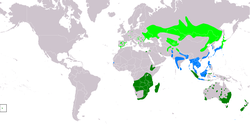| Baillon's crake | |
|---|---|
 | |
| Scientific classification | |
| Kingdom: | Animalia |
| Phylum: | Chordata |
| Class: | Aves |
| Order: | Gruiformes |
| Family: | Rallidae |
| Genus: | Zapornia |
| Species: | Z. pusilla |
| Binomial name | |
| Zapornia pusilla (Pallas, 1776) | |
 | |
| Range of Z. pusilla Breeding Resident Non-breeding | |
| Synonyms | |
Porzana pusilla | |
Baillon's crake (Zapornia pusilla), also known as the marsh crake, is a small waterbird of the family Rallidae.



